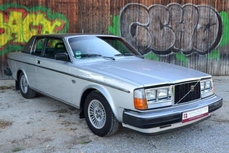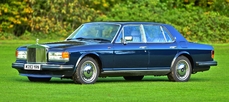Volvo 262 Bertone Bertone Coupe Automatic. 1979
Allgemeine Beschreibung :
1979 Volvo 262 Bertone Coupe Automatic.
Registration number: CMM262V
A very rare car of which some 6000 examples were made with most being experted to the USA. This example was UK supplied & is finished in immacualte silver metallic paintwork, the only colour available at first although Gold became an option later. This example is in superb order thoughout having covered 89000 miles from new & resided in a small private collection of unusual cars.
This car drives beautifully & has a solid feeling typical of the Volvo Brand. The interior is swathed in Black leather & burr walnut. Carpets that one might more usually find under foot are also used to cover the ceiing as a roof lining. The lusty V6 engine starts readily & provides plenty of go augmented by the three speed with overdrive automatic gear box.
Presented in very fine overall condition, this rare & collectable Volvo Coupe is ready for immediate use.
Volvo's Heritage side tells us the following:
Launched at the Geneva Motor Show in March 1977, perhaps the most unexpected Volovo model version saw the light of day: a two-door coupé with heavily slanting windscreen pillars and the roof lowered by 60 mm. To get the car to be perceived as sleeker, the rear spare wheel pods had been removed - the remainder of the body was identical.
What really made the 262C into what it was could be found in the passenger compartment. This offered an extravagance of leather and hardwood. The seats, headrests, door sides - even the curve handles had been upholstered in leather. When the Volvo 1800ES was discontinued in 1973, there was no natural successor to the role of top range sports model. Volvo’s CEO Pehr G Gyllenhammar saw this as a problem. It was especially important that there was a model of this kind in Volvo’s biggest export market in the USA and a luxury coupé seemed more right at the time than another sports car. Volvo’s chief designer Jan Wilsgaard did sketches for the shapes of the prestige car, but no clay model was ever built. Instead, he used a Volvo 164 that had been used to test new interiors. It was taken to the Italian designer Sergio Coggiola’s company in the Italian city of Turin, where the four-door body was rebuilt into a two-door body with a lower roof. The roof was clad with vinyl and the wide C-pillar adorned with three crowns - Sweden’s heraldic national symbol. The three crowns were replaced with one larger one on the production car, which is one of the very few differences between it and the prototype - except the obvious one that it was based on a 164. The engine in the 262C was initially a 2.7 litre, 140 hp V6. It was shared with all the other body versions in the 260 series and had been developed together with Peugeot and Renault. Manufacturing took place in Douvrin in France under the auspices of the Société Franco-Suédoise de Moteurs-PRV company. Volvo’s engine designation was B27E and thanks to engine blocks and cylinder heads made from aluminium, it weighed less than 150 kg. Such a niche product, built in small numbers, didn’t fit into the Volvo plant in Gothenburg. Instead, final assembly took place at the Italian Carozzeria Bertone, who also built the 264TE limo. Kits were sent to Turin where the bodies were modified, painted and assembled into finished cars. A small badge on the lower part of the front fenders showed that Bertone had built the car. For the first few years, the 262 was only available in silver metallic with a black vinyl roof. From 1979, it was also available in gold metallic without a vinyl roof. That year, all saloon models in the 200 series also received a new rear with a boot that went down at the rear edge. The tail lights were also new and went around the body corners. In 1980, black and light blue metallic and silver metallic with vinyl roof was phased out. In the USA, the model was sold under the name of the Volvo Coupé from 1980. The model year that stands out the most was also its last. In 1981, the 200 series underwent a major update with new, more slender bumpers and a new headlight set up. The B27E became a B28E as the engine gained in terms of cylinder volume and had another 14 horsepower added to it. The new colour combination was a two-tone paint job in gold and nougat. The aim was to manufacture 800 units per year, but expectations for demand had been set far too low. Apart from in 1977 when production started late in the year, and the final model year, production figures were more than double the forecast. When the final cars were sold in 1981, they were already considered to be collectibles. In total, 6,622 cars were built between 1977 and 1981.
1979 Volvo 262 Bertone Bertone Coupe Automatic. is listed zu verkaufen on ClassicDigest in Essex by Prestige House for Preis nicht verfügbar.
Fakten der Auto
Karosserietyp : Auto Marke : Volvo Modell : 262 Bertone Ausführung : Bertone Coupe Automatic. Hubraum : 0.0 Modelljahr : 1979 Karosstyp : Coupé Lage : Essex Fahrzeug Anmeldung : Undefiniert
Preis nicht verfügbar
Angaben Zum Verkäufer
Vintage & Prestige
Prestige House
+44(0)1375 379719, +44(0)7967 260673
Prestige House
+44(0)1375 379719, +44(0)7967 260673
People who viewed this Volvo 262 Bertone also viewed similar Volvo listed at ClassicDigest
Other cars listed for sale by this dealer
über Volvo
Volvo hat eine reichhaltige Geschichte, die über neun Jahrzehnte erstreckt, geprägt von einem Engagement für Sicherheit, Innovation und skandinavisches Design. Hier finden Sie einen Überblick über die Entwicklung von Volvo, einschließlich Schlüsselmodellen sowie das Design und die technologischen Highlights, die zum XC70 führen:Early Years and Foundation: Volvo wurde 1927 in Göteborg, Schweden, gegründet. Das erste Volvo -Auto, das Öv4 (Jakob), rollte 1927 von der Produktionslinie. Volvo erlangte sich schnell den Ruf, robuste und sichere Fahrzeuge zu produzieren.
Sicherheitsinnovationen: Volvo wurde zum Synonym für Sicherheitsinnovationen. In den 1950er Jahren stellten sie den Drei-Punkte-Sicherheitsgurt vor, eine bahnbrechende Erfindung, die weltweit Standard in Automobilen wurde. Im Laufe der Jahre war Volvo weiterhin Sicherheitsmerkmale wie Crumpelzonen, nach hinten gerichtete Kindersitze und den Schutz des Seitenaufpralls.
Designentwicklung: Die Designphilosophie von Volvo entwickelte sich, die skandinavische Einfachheit, Funktionalität und Sicherheit verbindet. Die Designsprache der Marke umfasste saubere Linien, Robustheit und einen Fokus auf den Innenraum.
Schlüsselmodelle im Laufe der Jahre:
Amazon (120 -Serie): In den späten 1950er Jahren wurde der Volvo Amazon ein elegantes Styling vorgestellt und wurde für seine Zuverlässigkeits- und Sicherheitsmerkmale beliebt.
140 Serie: In den 1960er Jahren wurde Volvo's Fokus auf Sicherheit vorgestellt und Innovationen wie Scheibenbremsen eingeführt.
240 Serie: In den 1970er Jahren wurde der 240 zu einem ikonischen Volvo -Modell, das für seine Haltbarkeit, Sicherheit und Kastendesign bekannt ist und fast 20 Jahre lang in Produktion verbleibte.
850-Serie: In den 1990er Jahren führte Volvo den 850 vor, der für seine innovativen Funktionen bekannt ist, einschließlich des ersten Modells mit Fünfzylindermotor.
XC70-Serie: Die XC70 debütierte Anfang der 2000er Jahre als Offroad-Variante des V70-Wagens. Es kombinierte die renommierten Sicherheitsmerkmale von Volvo mit Allrad-DRIVE-Fähigkeiten und einem höheren Bodenfreiheit für eine verbesserte Offroad-Leistung.
XC70 -Design- und Tech -Spezifikationen: Das Engagement von XC70 ist das Engagement von Volvo für Sicherheit, Vielseitigkeit und skandinavisches Design. Einige Design- und technische Highlights umfassen:
Robustes und funktionelles Design mit schützender Verkleidung und erhöhter Bodenfreiheit für ein SUV-ähnliches Erscheinungsbild.
Allradantrieb (AWD) -System für eine bessere Traktion auf verschiedenen Geländen.
Fortgeschrittene Sicherheitsmerkmale, einschließlich Volvo's City Safety System, mit dem Kollisionen in städtischen Verkehrssituationen verhindern.
Hochwertiger Innenraum mit bequemen Sitzen, ausreichend Frachtraum sowie moderne Optionen für Infotainment- und Konnektivität.























